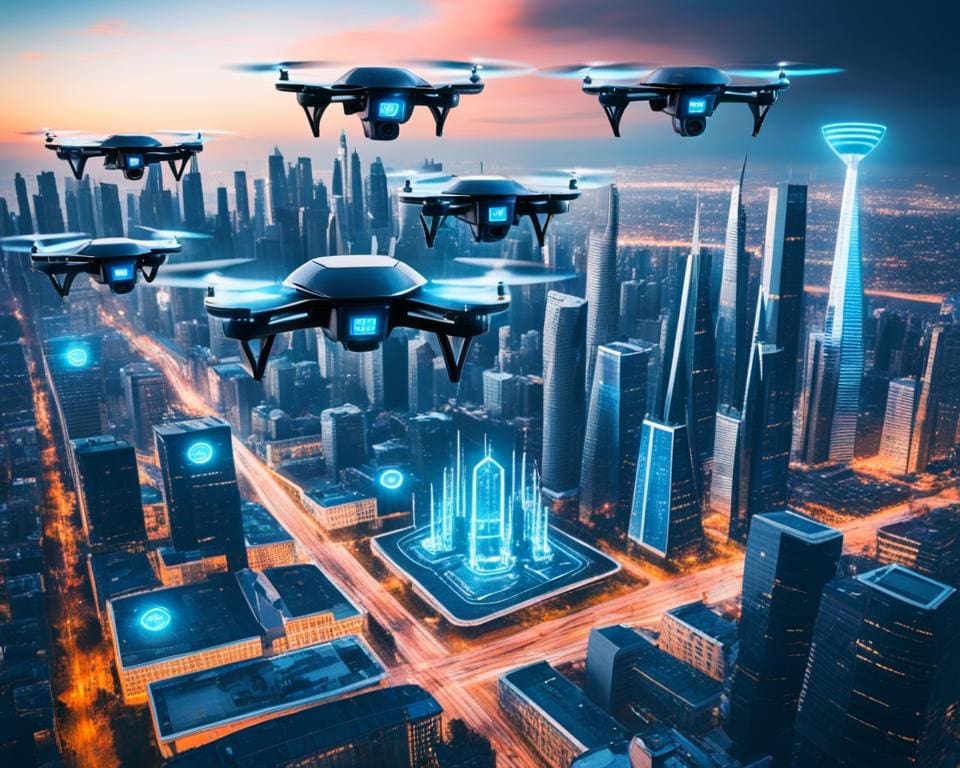The advancement of AI is changing cybersecurity fast. It brings us to a new digital age, needing strong cyber defences. The European Union’s NIS2 Directive urges using AI for better security. This shows how vital AI is for detecting threats.
A survey found 82% of IT leaders will use AI for cybersecurity soon. By 2027, spending on AI in cybersecurity could hit $46.3 billion. AI’s power to process data quickly makes it perfect for spotting risks and weaknesses.
AI is changing how firms fight cyber threats. It makes data analysis fast and simplifies routine security jobs. This lets cybersecurity staff work on bigger projects. With cyber threats getting trickier, using AI is a must for strong defence.
AI’s Transformative Role in Cybersecurity Technology
AI Security Solutions have become crucial in cybersecurity as organisations face a complex threat landscape. The 2024 RSA Conference highlighted the importance of boosting capabilities and defence. AI plays a role in threat detection, automated responses, and predictive analytics.
Enhancing Threat Detection and Response
AI transforms how security teams detect and react to threats. It excels at spotting threats in real-time by analysing lots of data. By identifying unusual activities and sending alerts, AI cuts down false alarms and improves security. Trend Micro uses AI to speed up detection, enhancing risk management and identifying daily threats.
Automated Incident Responses
AI has made incident response quicker and more efficient. It automates tasks in Security Operations Centres, reducing alert fatigue. For example, Torq’s HyperSOC automates system isolation and starts quick recovery. This fast reaction minimizes damage and keeps operations stable. AI supports, not replaces, human analysts, boosting the effectiveness of security operations.
Predictive Analytics in Cyber Defence
Machine Learning in Cybersecurity proactively manages threats. It predicts threats and patterns by analysing past data, giving organisations time to strengthen their defences. This approach prepares firms to deal with evolving threats, promoting a proactive cyber threat culture. It’s essential for staying ahead in the digital world.

The Future of AI in Cybersecurity: What’s Next?
The way artificial intelligence and cybersecurity blend is rapidly changing. As organisations work to strengthen their defences against increasing threats, cutting-edge AI Security Solutions will become key. We will look at notable advancements and trends moulding the Future of AI in Cybersecurity.
The Evolution of AI Security Solutions
The EU’s NIS2 Directive highlights the need for advanced tech like AI in cybersecurity. AI tools can now analyse network traffic, user actions, and system logs. This helps in spotting potential threats.
With machine learning, organisations can identify and block various cyber threats such as malware, phishing, and ransomware. These AI tools also help in real-time threat spotting. They review software code to find and fix security weaknesses quickly.
Generative AI: A New Frontier in Cybersecurity
Generative AI is becoming crucial in cybersecurity, especially for improving defence measures. It uses data from past cyber attacks to better predict future threats. AI also monitors user behaviour to spot suspicious activities, like odd access patterns.
This strengthens Cyber Defence Tools. A significant amount of IT decision-makers plan to invest in AI-driven cybersecurity solutions. This means the collaboration between human smarts and AI tech will make cybersecurity tougher and more adaptable.
Challenges and Ethical Considerations of AI in Cybersecurity
AI brings big benefits to cybersecurity, like spotting threats faster and planning better reactions. But, it’s not without its problems. The main issue is keeping private data safe. This is tough because AI needs a lot of information to learn, which can clash with keeping things secure. Beyond that, AI systems sometimes flag things as risks when they’re not, causing alert overload among professionals.
When it comes to AI’s ethics, bias in the data used for training is a big worry. This bias might lead to unfair results, impacting decisions in real life. Also, AI’s workings can be tough to understand. This makes it hard to trust it fully when facing serious cybersecurity issues.
To fight ever-changing cyber threats, organisations must constantly update their AI strategies. It’s crucial to use advanced techniques, like adversarial training, and keep data anonymous. Doing so helps fix AI’s weak spots. In the end, AI is a strong tool in battling cyber threats, but it requires a careful ethical approach and a commitment to protecting data.









